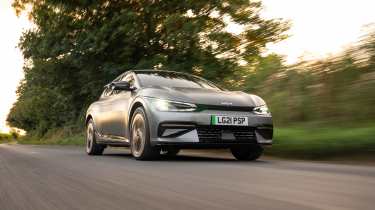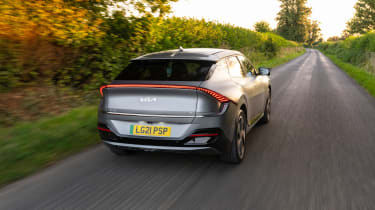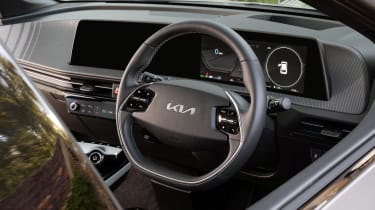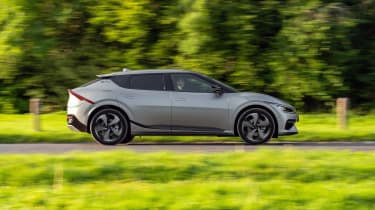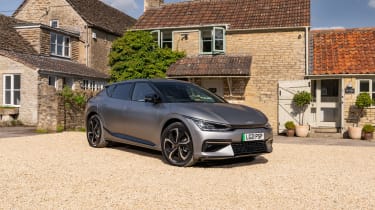Kia EV6 GT-Line S prototype review – the EV that shows how it’s done
A rounded and fundamentally sound electric car that’s distinctive without being off-putting
The influx has begun; bespoke EVs from all manufacturers are reaching the road with some serious momentum, introducing not just new models for legacy brands, but whole new ranges, sub-brands and therefore ideologies. This curious looking creature is Kia’s EV6, and while it’s not the first electric car from the Korean giant, like Hyundai’s Ioniq 5 it is the first of Kia’s new generation, underpinned by a multi-billion pound investment in a new bespoke architecture.
Yet unlike the Ioniq 5, which takes the form of a quasi hatchback-cum-crossover, the EV6 takes a slightly different route by offering up a sleeker and more elongated silhouette. This is reflected in the EV6’s chassis set-up too, with this 321bhp dual-motor version packing a more dynamically focused handling package atop its 77kWh battery pack. The EV6 range will eventually grow to include a high-performance 577bhp GT version too, but for now this GT-Line S model will top the range, and become a centrepoint for Kia’s EV assault to grow in all directions.
As you approach the EV6 in the flesh what hits you first is that, like the Ioniq, it’s much larger than it looks in pictures. Those wheels, which look a little lost in the arches, are actually 20 inches in diameter, and while the lighting elements look sleek, sharp and delicate, in reality it’s all quite substantial, upsized to hide the overall body’s true dimensions.
More reviews
The design itself is also extremely angle sensitive, with that short nose and wrap-around windscreen, and you’ll often catch some very odd angles around the front wheels and headlights, with those manta ray-looking fins in the lower bumper catching the light and pulling the visual mass in towards the centre. Its rear end is far more successful, however, with a modern and fresh interpretation of a Kamm tail framed by striking rear lights and a floating fastback roof. Both do a very good job of hiding the upright proportions of the EV6, catching lots of interested glances from bystanders and other road users in the process.
Inside, the Kia’s dash presentation is also well thought out, both ergonomically and aesthetically. Finding a balance between wanting a clean interior and not burying key functionality within layers of digital interface is one that the EV6 does extremely well, with a pretty typical dual-screen set-up augmented with physical controls both on the dash and the floating centre console. Overall the system does work very well, and although Hyundai/Kia’s digital interface isn’t the slickest on the market it is functional, and once you’re acclimatised most everyday functions are easy to execute.
Yet the chassis is where the money has been spent, and you can feel it. Underpinned by Hyundai and Kia’s jointly developed e-GMP platform, they have developed it to form the basis of multiple models across both brands, and premium offshoot Genesis. In the case of the EV6, its hardware might be largely the same as that of Hyundai’s Ioniq 5, but the shorter wheelbase and fundamentally sound chassis tuning has yielded big benefits, with the EV6 feeling much more spritely and composed than its somewhat dowdy looks might suggest.
Aside from some initial gloopiness at low speeds the steering is natural and accurate, with a linear rise in steering weight as the load on those 20-inch front tyres increases. This weight, and the ratio’s speed itself, feels extremely well calibrated to the body and its movements as you flow through a corner. The suspension tune on this prototype was at about 90 per cent production standard, so too the non-UK specification Michelin tyres (UK cars will be fitted with Continentals), yet regardless the ride quality was impressive on the broken roads of our test route, with just enough lateral support to keep the 2105kg kerb weight in check.
Yet it’s Kia’s experience with EVs that shines most brightly in the brake pedal feel and throttle calibration, both of which are standout amongst all electric cars, regardless of price. No EV does such a good job of blending the regenerative and friction braking systems, the pedal has no discernable change in feedback throughout the travel and the brakes themselves are also immensely strong, giving you extreme confidence, whether coming to a smooth stop at a junction or entering a corner at speed.
The throttle is equally well-considered, with the pedal feel and response changing between the driver modes, but each with an intuitive and resolved feel. You don’t find yourself second guessing or being caught out by inputs to either pedal, which isn’t something that can be said of many EVs. Actual performance is impressive too, with the EV6 reaching 62mph in 5.4sec on paper, but feeling even more well endowed on the road.
What the EV6 feels like is an electric car developed by a team that had a clear idea of what they wanted the car to be from its inception, backed up by the experience and budget to execute it properly. In contrast to its bizarre undefined form, it really is a very impressive family car of the future that does everything it needs to as a solid, reliable and satisfying everyday car for the everyday consumer. This also proves that Kia’s foundation underneath the EV6, and the incoming GT that’ll follow, is a solid one, paving the way for some fascinating new products that are no doubt still to come.
Prices and rivals
All EV6 models in the UK will make exclusive use of the larger 77kWh (useable) battery pack, and come with either single or dual motors. The dual-motor GT-Line S we drove will start from a chunky £52,000, but prices for the entry-level model just break the £40k barrier. This is a few thousand more than Hyundai’s Ioniq 5, but then it does feature a larger battery pack to compensate at the entry-level.
The easiest rival to consider at this price point is the Tesla Model 3, which is impressive in some respects – the blue-sky thinking, excellent performance and user interfaces – but suffers from some pretty appalling lapses in build quality and doesn’t drive nearly as well as the Kia. BMW’s incoming i4 in its lesser trims will also be a key rival for the Kia, and while it does have some useful advances in battery and electric motor tech for BMW, its combustion-based chassis makes it more compromised in terms of its packaging. Yet here’s the real kicker. This Kia’s two main rivals are from Tesla and BMW, which to us says volumes about how the journey to electric is changing brand perceptions faster than ever before.

